Caitlin Doughty's Blog, page 18
October 13, 2018
October 8, 2018
September 14, 2018
Ask a Mortician: EXHUMATION
September 7, 2018
ICONIC CORPSE – Ferdinand Marcos
September 5, 2018
Faces of Death: Katrina Spade
Tell us about your work, Katrina.
I’m the founder of Recompose, which was formerly the Urban Death Project. Back in graduate school, I invented a system that turns human bodies into soil, based on decades of practice by farmers composting livestock and other animals. Recompose is now developing that system to make it available to the world.
I’m excited to help solve the problem of the pollution and waste caused by contemporary disposition options, but I’m also really excited to weave ritual, participation, and transparency into death care. Besides offering a way to return our bodies to the earth, Recompose is designing an experience for families that is quite different from the typical funeral home, both aesthetically and emotionally.
I started this work because I saw the funeral experience as something worth improving, and I’ve since had several deaths of loved ones really affirm that idea. I love all the aspects of this work, from policy change to cultural shifting to designing and engineering…I even love the excel spreadsheeting!
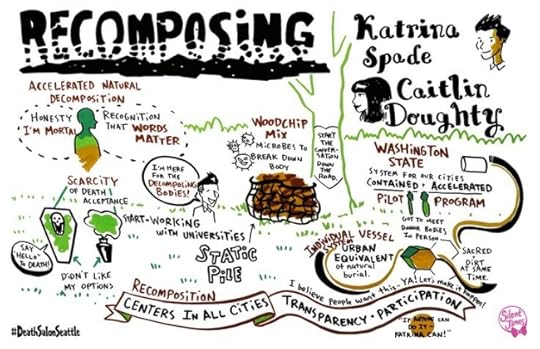
Live illustration by Silent James, at Death Salon: Seattle
What are you working on this year?
This year, we’ve been partnering with researchers to prove that recomposition is a safe and effective method of disposition. We’re introducing legislation to make recomposition legal in Washington State. And we’re manufacturing and testing a prototype of our system, all with the goal of opening the first Recompose Center in the next few years. We’ve also been raising money from heart-aligned investors to move this whole adventure forward.
What does death positivity mean to you?
Lately, I’ve been focused on lack of judgement as the heart of death positivity.
Like, no one can tell you how to feel when someone dies. And no one can tell you how to feel about your own mortality. And you can change how you feel every three seconds, if you want.
When I think about staffing our Recompose Centers, I think about hiring folks who are awesome at guiding people through an experience and providing the opportunity to participate… but completely without judging or insisting.
We’ve also been raising money from heart-aligned investors to move this whole adventure forward.
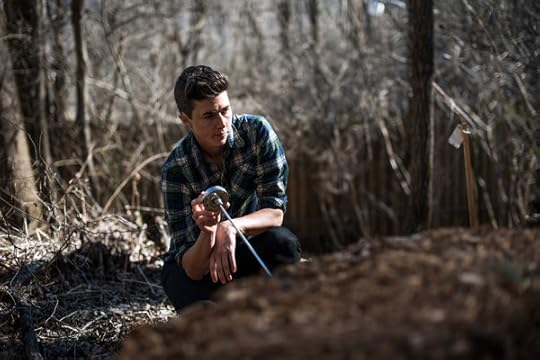
What other death-related job that you don’t have, would you want?
I’d love to try my hand at designing a beautiful crematory. I’d also like to do voiceovers for death-related shows….hmmm, I guess I just want to do voiceovers in general.
When you die, what do you want done with your corpse?
I’d like to be recomposed, and have my kids plant a little something with the soil.
If that can’t happen for some reason, I’d like to be super-embalmed and dressed like I was going to play tennis…then perched on a bench like I was calmly watching people play at the local Seattle courts.
You can find out more about Katrina’s work by visiting the Recompose website, and watching her Ted Talk, When I Die, Recompose Me. Katrina has been featured in the New York Times, and architecture and design magazine, Metropolis.
You can follow Katrina on Facebook and Twitter.
If you enjoyed this piece, please consider supporting our work. Your contribution goes directly toward running The Order, including resources, research, paying our writers and staff, and funding more frequent content. We’d love to keep pushing the funerary envelope in 2018. Visit our Support Us page, for a variety of easy ways to contribute.
DEATHBED PLANNING with a Death Doula
August 15, 2018
Deathstagram
People are using Instagram in innovative and meaningful ways, especially when it comes to the subject of death. Here are ten different accounts that are using the social media platform to help them grieve, create spaces to talk about death, bring comfort to families who are victims of violence, and showcasing the power of meaningful death rituals around the world.

Dead and Alive Project – @deadandaliveproject
Photographer Klaus Bo has been travelling the world for the past seven years exploring various death rituals in an effort to help death-avoidant Western societies understand the importance of funerary rituals, and cultivating a healthy relationship with death and our dead.
Bo says, “Today we are obsessed with youth. People don’t want to grow old and they don’t want to die. We repress death. I want us to learn from other cultures. I want us to embrace our dead. The dead are not gone, they are alive in our hearts.”

The Shed Project – @leejohnphillips
For the past few years artist Lee John Phillips has been drawing every single item in his grandfather, Handel Jones’ work shed, as a way to honor and remember him after his death. “My grandfather passed away…and my grandmother treats (the shed) as a mausoleum. Neither she, or the shed will be around forever., I’d like to preserve it for my family,” Phillips said.
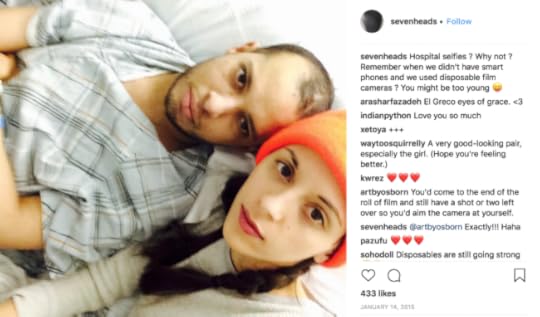
Seven Heads – @sevenheads
“This Instagram is sooner or later, a tombstone.”
Jonathan Waiter was a New York fashion photographer who died from non-hodgkin lymphoma in 2015. His @sevenheads account documented his life, and the end of it.
In a short film made about Waiter’s choice to share his death on Instagram, he talks about how his doctors avoided talking about anything that didn’t “inspire hope,” and of the many unhelpful messages he received that used language like “fight” or “battle,” as though his death was simply a matter of choice. Waiter spoke openly about his thoughts and feelings sharing, “…there is that darkness that looms and it’s like the entire spectrum of emotion demands to be felt at once. Everything is violent and everything is bright. I think it was always like this, I just couldn’t see it with such clarity. I certainly do now, and now everything is painful and beautiful at the same time.”
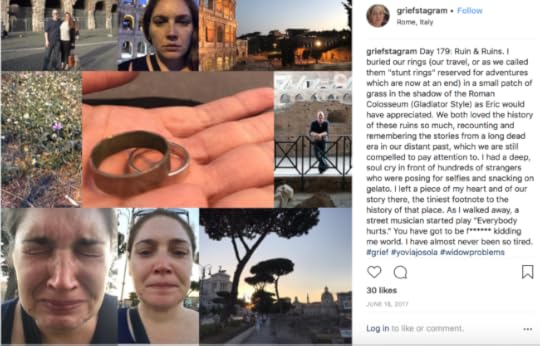
Griefstagram – @griefstagram
When Kate George’s husband died, she had difficulty finding content that reflected the reality of grief. “The few images I had seen of grief in the media strongly influenced my experience of it in the early days. Before my husband’s death, I had mostly learned about grief from the movies…I had seen friends and family members grieve at funerals, but what happened later I never saw. I now know I did not understand grief all. Not knowing what grief really looked like made all of my actions and emotions feel just plain wrong. I have learned that grief is so much more complicated, subtle and variable than I ever thought.”
On @griefstagram George’s posts are heartbreaking, raw, and also…funny. By sharing the complicated realities of grief she also provides comfort and community, by helping others in mourning feel like they aren’t so alone.
Kevin Budnik – @kevin_budnik
There have been some outstanding graphic novels and comics recently whose stories address death, loss, aging and mortality, including Can’t We Talk About Something More Pleasant? by Roz Chast, and the new series, Euthanauts from Tini Howard.
One memorable example of people using art to bear witness to and help make sense of the things we so often struggle to put words to, can be found on artist Kevin Budnik’s Instagram. Here, Budnik uses his art as a way to process his emotions and share his thoughts as his father is diagnosed with cancer, undergoes treatment, and as he and his family grapple with anticipatory grief.
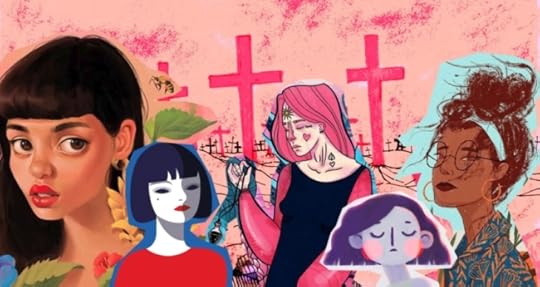
Via revistaespejo.com
No Estamos Todas – @noestamostodas
No estamos todas, (which translates to “we are not all here”), endeavors to cultivate awareness about the staggering number of femicides throughout Mexico and other parts of the world. The project is regarded as being part of by activists calling for an end to gender-based violence.
Contributing artists compile information about the victims to create portraits honoring the women’s lives. Captions always begin with the stark reminder that “No estamos todas, nos falta…” – “We are not all here, we are missing ______” followed by the victim’s name.
The co-creator, an activist who uses the name Frida Guerrera, says she hopes that the project will have a lasting impact. The women participating stated, “We [want the project] to be a celebration of their lives. We want to remember [these women] as people with aspirations, histories, and dreams.”

David Orr – @davidorrart
For the past decade David Orr been traveling to the sites of people’s violent deaths and photographing the skies above for his ongoing project, All That is Solid Melts into Air. The images serve as both portraits of absence and as abstract memorials to the individuals represented.
“The skies will still be here long after structures, landmarks and addresses have become altered or disappeared entirely. What I photograph will never be the same sky as when the death occurred and that is an essential point of the series. Something happened, but the world moves (and has moved) on.”
You’ll also find images from Orr’s series on human skulls entitled Perfect Vessels on his feed.

Preston Gannaway – @pgannawayphoto
For many of us, our pets serve as our sole constant figure of love and support throughout our lives. Though we experience many changes and uncertainties, our animal companions are there through moves, relationships, family disharmony, and job changes. The relationship we forge with such special partners is unparalleled, and when they die, the loss can be devastating. So it was for Preston Gannaway and her cat Isis, named after the Egyptian goddess. The pair shared almost seventeen years together, before Isis died in 2015.
As a way to help her grieve, Gannaway decided to post a photo of Isis on her Instragram every day for 100 days, tagging them #100daysofisis. In one of the photo captions. She says, “It’s so easy and tempting for me to get busy with work and just bury the loss. But this odd commitment I’m trying to keep forces me to spend time with her, at least in the only way that I can now. And then I savor it.”
Gannaway is no stranger to documenting grief and loss through her lens. As a photographer, she won a Pultizer for her series Remember Me, in which she spent two years with a family coping with a terminal illness, and eventual death.

I Had a Miscarriage – @IHadAMiscarriage
An account that was created by Jessica Zucker, a psychologist who specializes in reproductive and maternal mental health, after experiencing her own heartbreaking and traumatic loss.
@IHadAMiscarriage creates a space where people are able to share their personal stories of loss, and help break the silence surrounding their feelings and experiences of shame, guilt, isolation, grief, and invisibility that often accompany reproductive loss and infant death.

Adriana Zehbrauskas – @adrianazehbrauskas
In 2014, 43 students from the Ayotzinapa Rural Teacher’s College in Mexico were forcibly disappeared. Details surrounding their disappearance are mired in controversy and officials have not been forthcoming. In result, families have been left with few answers or support from the agencies that are supposed to be aiding them, leaving many in a state of perpetual limbo and grief.
While working with families of the 43 disappeared, documentary photographer, Adriana Zehbrauskas “….noticed that none of them had family photos – all they had were snapshots taken on their cell phones that were lost or accidentally deleted. Nobody printed any more pictures. It struck me that these people were not just denied a future with their loved ones, but they were also denied a past – with the lost photos, their memories would also eventually vanish. And who are we, without our memories?”
As a response, Zehbrauskas created Family Matters, a portrait series of the families backed by the Getty Images Instagram Grant. Zehbrauskas would bring along a printer on her shoots to provide each subject with a tangible copy of their image. “We try to assert that in a world of constant change and inevitable loss, there are things that time has no right to destroy,” the portraits are her way of reinforcing this idea.
Sarah Chavez is the executive director of The Order of the Good Death, and co-founder of the feminist death site Death & the Maiden. In addition to working as a museum curator she writes and speaks about a variety of subjects including the relationship between food and death, feminism and death, as well as Mexican American death history and decolonizing death rituals. You can follow her on Twitter .
If you enjoyed this piece, please consider supporting our work. Your contribution goes directly toward running The Order, including resources, research, paying our writers and staff, and funding more frequent content. We’d love to keep pushing the funerary envelope in 2018. Visit our Support Us page, for a variety of easy ways to contribute.
August 10, 2018
Dying Fat: Your Funeral Options
August 8, 2018
Dying Queer in 2018
“There would be lots of color, a parade down the street, with people carrying portraits of her. Music and laughter; a New Orleans style funeral,” said Fay.
Fay Slift, also known as The Lady Bear Extraordinaire, is a well-known Toronto drag performer who helps run the wildly successful Story Time With Drag Queens, where children hear their favorite story from a larger-than-life princess. Monday through Friday Fay teaches at an elementary school. I’ve asked her to imagine what a perfect drag funeral would look like.
“Everything about drag,” she says, “Is full of life. It’s humorous, ironic, and it’s over the top. Full of color and a celebration,” she goes on, clearly enjoying imagining this kind of gala. “A drag funeral should be just that.”
Fay Slift, The Lady Bear Extraordinaire.
But is that possible?
I set out to write this article with a simple question: what is it like to die, queer, in 2018?
In 2005, Canada became the fourth country in the world to give people the legal right to marry someone of the same gender. I live my life in my early thirties as an openly gay man, experiencing no prejudice from my friends, family or employer – but what might it be like at the end of my life? What about people of my community who don’t enjoy the same acceptance that I do?
Nathan Romagnoli owns Eco Funeral in Toronto, but for many years he worked at a large corporate funeral home, where he was not out of the closet.
“A woman called to make arrangements for someone, another woman,” He said, “She wouldn’t tell me who the deceased was. Eventually it became clear it was her wife who had died, but the woman I was speaking with didn’t know if she was in a safe place where she could disclose that. It’s just lucky she called, and happened to get me.”
The sad truth is, as Nathan explained to me, if she had by chance, got a different director at the same home she may not have been in a safe place.
Nathan’s instincts were reinforced by his boss at the funeral home where he worked.
“He’d invite me over to dinner with him and his wife. He understood who I was, but he later told me that for my work, I should never disclose that part of myself,” Nathan said.

Jake (name changed) is a director at a funeral home in the gay village of Toronto which operates as part of the Dignity Memorial group, based in Texas. Their website offers the platitude, “Celebrating each life like no other.” They operate over ten funeral homes in Toronto.
When I spoke to Jake on the phone I briefly outlined what I was writing about and why I wanted to talk to him. He mentioned his home’s ‘deep ties’ to the local (ie gay) community and how they felt it was an honor to help people from the community.
I asked if we could sit down and talk and Jake told me to email him to set up a time.
Jake needed the permission of the funeral home’s district manager to talk to me, and that person was on vacation. When they got back, Jake told me he would need to talk to the head office before he could speak with me. I was later told, the managers would have to speak to their communications and media relations departments before he could talk to me, and asked if I could submit a list of every question I might want to ask during the interview.
I am writing this article six weeks after my initial contact with Jake, and all I can really say is that when asked about funerals for people in the queer community, the Dignity Memorial Group was not forthcoming.
Stanton has a gravely voice and, when the humidity cooperates, a perfect pompadour. He has broad shoulders and a slightly louche 5-o’clock shadow.
When he went to the emergency room in a Toronto hospital not too long ago he was assigned a nurse that would only refer to him as the female she believed he was born as.
“I’m lucky. My family is, “in the know,” I guess you’d say,” he said.
Stanton, like many of us, hasn’t thought too much about his death, and he is lucky that his family knows who he is.

Laura Sussman, photographed by Aaron Mayes.
“Making plans yourself is so important, know what you want and tell someone (a funeral director).” said Laura Sussman.
Laura is co-owner of Kraft-Sussman Funeral and Cremation Services, a home that was recognized by The New Yorker for helping families of the victims in the Las Vegas mass shooting last year. She spoke to me on the phone in the midst of a hectic day at her funeral home.
The death of a person often inspires an ‘ownership’ battle over the deceased. If the person who died does not have a will or advance directive designating an agent, the decisions for planning their after-death care fall to their legal partner, if they have none, control falls to their parents who must make the decisions. If the parents are dead, their siblings. If they have no siblings, an aunt or uncle; and so on. This can become particularly problematic within the queer community, where being estranged from one’s family is not uncommon.
Laura told me the story of a trans woman who her home took care of. The woman had come from a Jewish orthodox family who, it seemed, she was no longer close with. Upon her death she had not left a will and had no legal partner, so decisions concerning her after-life care fell to her family. They insisted that her body be washed and prepared by male family members as is the tradition for male orthodox Jews.
Her family swooped in and decided how they wanted the person they thought of as their son taken care of, ignoring not only what, presumably, would have been her choice, but also her life and who she was.
This underlines Stanton’s story. Although acceptance in our society has grown, and many people are able to live their lives and be who they are, at times of crisis or moments in life where they are not able to speak for themselves, the ability to retain that freedom and maintain their identity can be greatly compromised.
“So many folk in the trans community don’t get a proper death,” Stanton told me, “The rate for murder is so much higher than cis-gendred people, the number of people that are street involved. It’s just so different.”
No one likes to think they that the life they are going about day to day will end, but there is no escaping the fact that one day, you too, will die. This thought is important for everyone, but even more so for people who are part of the queer community.
Dia de Muertos altar created by the Translatin@ Coalition in Los Angeles.
The unfortunate truth is that, unless you make legal decisions in life, your chosen family may be silenced when it comes to your after-life decisions.
“Her funeral was terrible,” Fay told me about the service for a well-known Toronto drag queen. “I mean, I guess they tried, but it didn’t work.”
The service she described had many of the costumes of the queen who passed away laid over the backs of chairs. It’s easy to imagine sparkling, sequined gowns with gloves and hats draped over the backs of chairs as though discarded.
“I would have had mannequins,” Fay said. “These clothes, these costumes, had so much life in them, they should have been displayed in a way that continued that.”
When I spoke to them I asked both Nathan and Laura about a drag queen funeral and if someone wanted their drag mother (the queen that taught them how to do drag) to do their post-mortem makeup.
“Its not uncommon to have a family member come in to help prepare the body,” said Nathan, “So I don’t see the difference.”
The tag line of Nathan’s funeral home is “Life Celebrations Done Uniquely,” and his sentiments in our conversation echoed what Fay imagined, the rituals surrounding the end of a person’s life should reflect their life, however they lived it.
Daniel R Wilson is a visual artist and writer in Toronto. His writing has appeared in The Toronto Star and several other publications. Being born the day before Halloween, Daniel has always had a keen interest in death.
If you enjoyed this piece, please consider supporting our work. Your contribution goes directly toward running The Order, including resources, research, paying our writers and staff, and funding more frequent content. We’d love to keep pushing the funerary envelope in 2018. Visit our Support Us page, for a variety of easy ways to contribute.
Caitlin Doughty's Blog
- Caitlin Doughty's profile
- 8406 followers



